Our volley tennis study guide teaches you all the basics to improve your game at the net.
Although players with big, booming groundstrokes have come to dominate singles, the art of volleying is not dead, at least not for the moment. A regular volley in tennis appears to be simple and intuitive when watching the pros play. But, on the other hand, volleys don’t look so easy when you find yourself at the net and have an extremely hard-hit tennis ball coming at you.
While most active tennis players are less likely to work on their volleys these days, having an effective net game can give you an advantage on the court. Volleys are instrumental not just for singles but also for doubles. If you have a strong volleying game, you will be able to be more dominant, keep the points short, move less, be less tired and beat more opponents.
This article will cover all the fundamentals of volleys, such as what a tennis volley is, in essence, and how to hit one with proper tennis technique. Due to the length of this article, feel free to jump to the most interesting sections. However, the following is a summary of the information found below:
What Is a Volley in Tennis?
A volley is a stroke made before the ball lands in a player’s court. This broad definition also extends to other sports; in soccer, for example, a volley is a shot taken by a player when the ball is off the ground (i.e., in the air).
A player who intends to volley a shot will generally move closer to the net, anticipating the direction of their opponent’s shot and making contact with the ball before the first bounce. Volleys in singles usually end the rally on the shot or put the opponent under pressure with the volley technique and win it with the next shot.
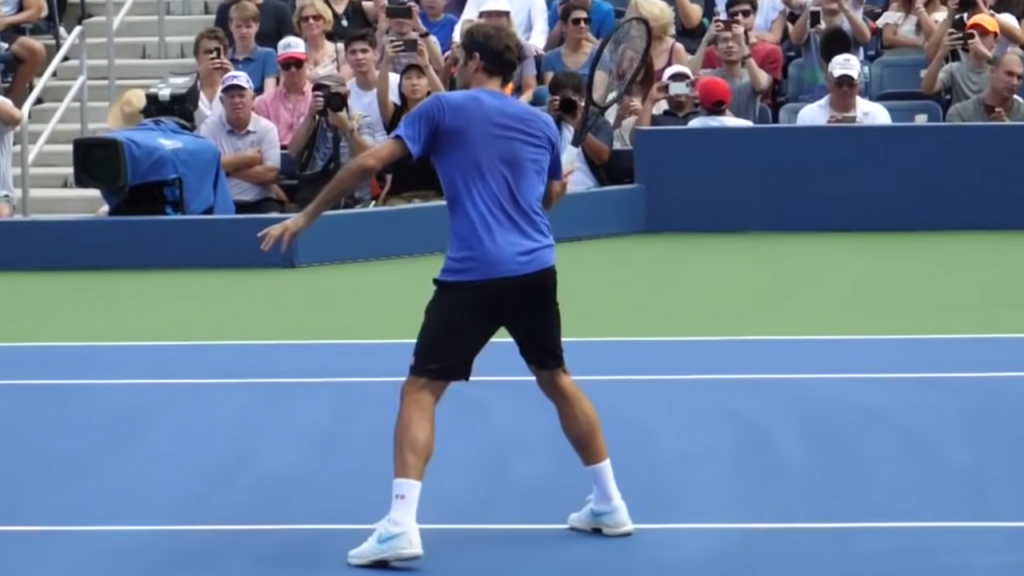
The main distinction between a volley and a baseline stroke is that on the baseline stroke, you are attempting to add speed to the ball, whereas at the net, you are attempting to use the speed of the ball coming towards you and divert it in a different direction.
Tennis Volley Grip
First and foremost, it’s important to have the right grip when hitting volleys properly. If you don’t have the correct grip, you won’t be able to hit good volleys consistently or have a good net game overall which would make you a very one-dimensional player.
When volleying, you must have instinctive reflexes, which is why using the identical grip (continental grip) for both types of volleys is vital, as you have a lot less time to switch grips compared to hitting groundstrokes. If you choose to hit a swinging volley, you can utilize your forehand and backhand groundstroke grips for the first shot and then switch to the continental grip for the next shot.
Swinging volleys are mostly used to finish a point or to approach the net. The continental grip is the right grip to use at the net for the forehand volley and backhand volley and is what most tennis players use.
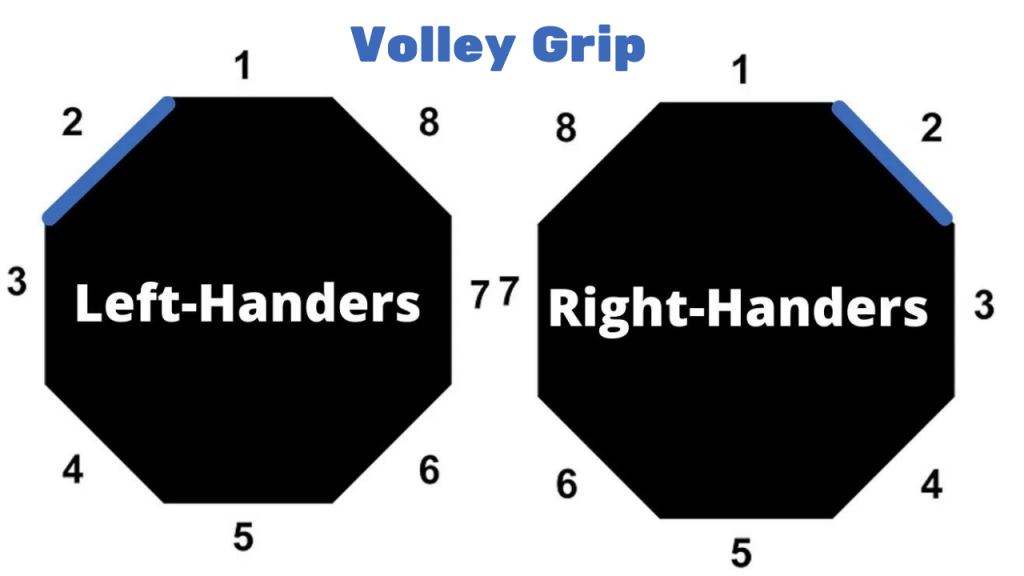
Your index finger’s knuckle should be directly on bevel number 2. The Continental grip is also ideal for shots that do not need much spin, such as serves, volleys, slices, and overheads. When hitting a volley, the wrist’s stability is also important. This grip position aids in your stability. In addition, this allows you to have more control over your stroke.
Tennis Volley Footwork
Using the proper footwork routines will allow you more power on your volleys while also reaching wider balls, making you a more difficult player to beat at the net. When the ball comes close to you on your forehand volley, step into the contact point with your left leg if you’re a right-handed player.
When hitting forehand volleys, imagine making a half-lunge; this move will help you stay balanced. This will also aid you in shifting your body weight into the volley, increasing its power and stability at the point of contact. For a volley on your backhand – for right-handed players, try to step into contact with your right foot.
This step forward will aid you in getting your body weight behind the volley. Finally, you shouldn’t swing harder to get adequate power on your volleys. Rather, use your body to add strength.
Keep Your Knees Slightly Bent:
When approaching the net, you should have your knees slightly bent, allowing you to be more mobile.
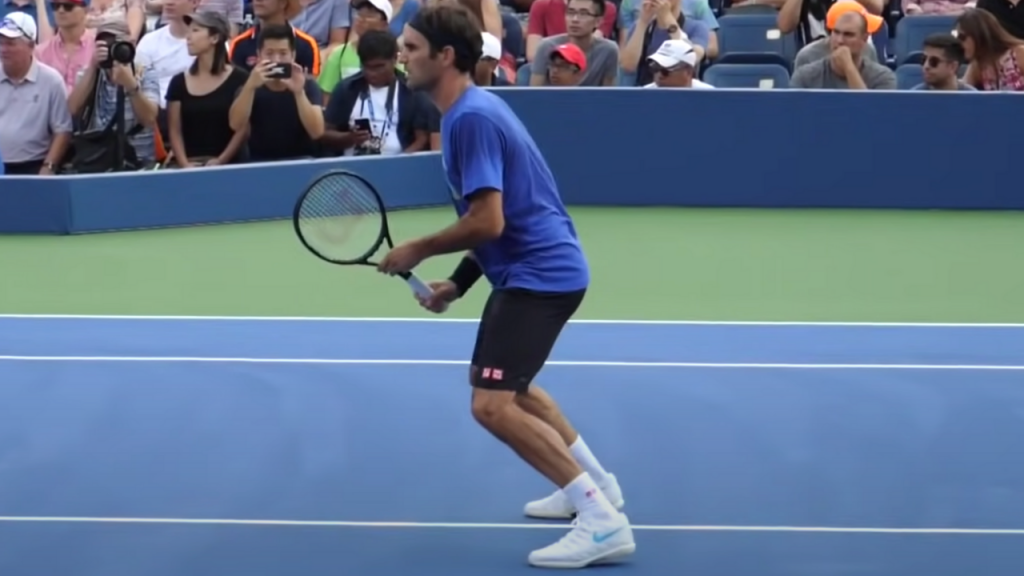
Maintain Your Weight On The Balls Of Your Feet, as shown in the image above. Doing so will naturally keep your knees bent and your entire body leaning forward, also shown in the image above.
Small Steps:
Besides the split step, move in small steps, preferably on your toes, except for one large step when hitting the ball. As a result, you’ll be more mobile and can respond better to changes in direction.
Tennis Forehand Volley
The forehand volley is a straightforward movement in which you use only one arm to hit a ball by your dominant side without allowing the ball to touch the ground. A player typically hits a forehand volley while standing close to the net and inside the service box. It necessitates strong hands and quick reflexes.
Tennis Backhand Volley
The backhand volley resembles a backhand slice without allowing the ball to touch the ground. A volley, once again, usually occurs when you are standing close to the net. Backhand volleys are always performed on your non-dominant side.
Backhand volleys are typically taught as a one-handed shot, but singles players are not uncommon to hit backhand volleys with both hands. Backhand volleys are essential to your net game because they allow you to shorten points and take time away from your opponent to prepare for their next tennis shot.
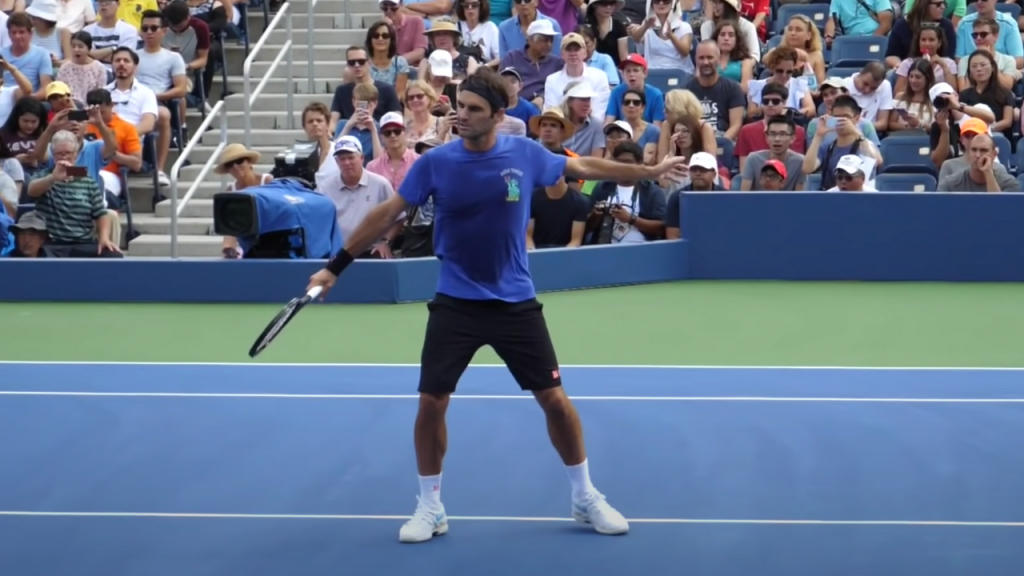
Tennis Volley Position
Volleys are typically played somewhere in the service box area. The goal, however, is to get as close to the net as possible. This is because you have the best chance of winning the point there. In this situation, you must find a neutral position for your body to be ready to redirect the incoming shot.
You take a wide stance and bend your knees in this neutral position. Next, hold the racket vertically in front of your body with your dominant hand. In addition, the other hand reaches for the racket’s throat. Extend your arms forward in the middle so that the racket and arm form a right angle. The racket face should be parallel to the court’s sidelines. Keep your focus on the ball from this ready position and point in time.
Volley Backswing
It’s helpful to think of the backswing on volleys as putting the strings behind the ball’s path. In some cases, however, the racket is positioned just above the point of contact with the swing having a subtle downward path. However, simply getting the racket behind the incoming ball is sometimes best, particularly for beginners.
The upper body rotation occurs through your torso and hips rather than just the arms. This will aid you in keeping your motion stable and strong. Your racquet shouldn’t extend past your shoulders. If this occurs, it indicates that you have gone too far. When hitting any kind of volley, you should always keep your racquet within eyesight, or you’ll most likely be hitting the ball too late if you do.
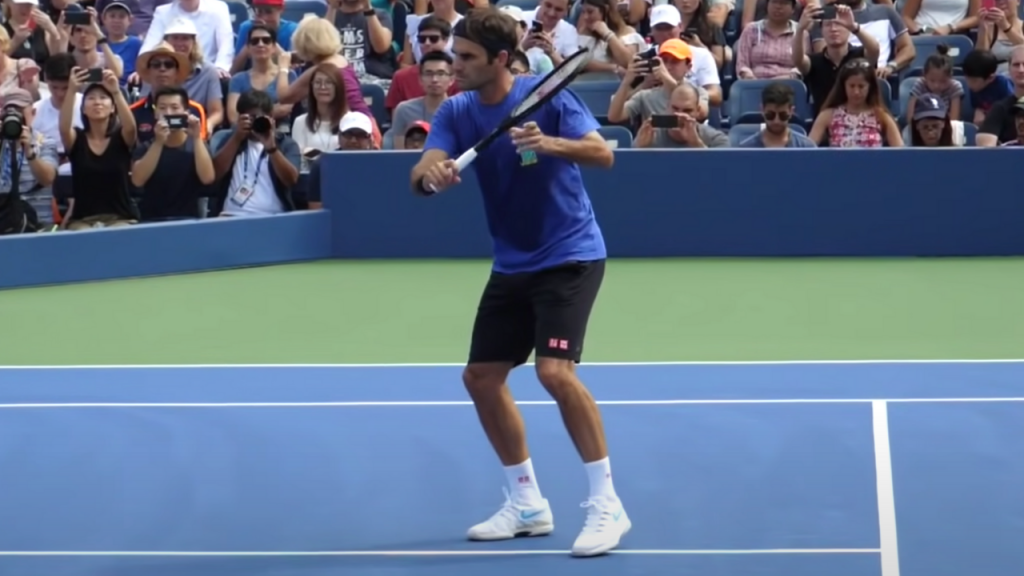
Contact Point
Because there is only a slight backswing, the path to contact is also quite short. If you position the racket behind the ball’s path, the movement toward contact will be very controlled. Yet, it is critical first to understand the perfect point of contact. Clean contact should be made in front of the body on the forehand volley, with the wrist being in a laid-back position.
The backhand volley makes contact on the side of the body, with the shoulder, elbow, wrist, and racket all in one line. When hitting the volley, always move forward and not sideways or backward. Also, your body weight and feet should lean forward and move into the shot.
Then, as you play the volley, shift your weight from your back to your front leg while unlocking your hips from a closed position to allow your arms, shoulder, hips, and torso to unleash energy through the racket and into the ball.
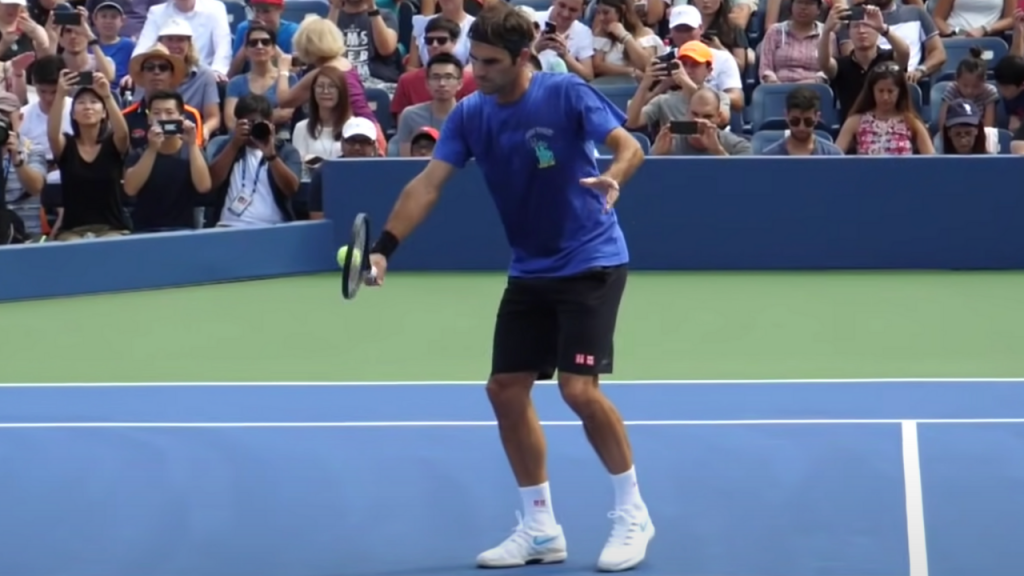
Best Tennis Volley Drills
Reading about proper volley technique is one thing; going out and practicing requires effective volley drills. So making dramatic changes to your volley technique during a match is simply not feasible. We’ve compiled a list of some of our favorite volley drills to help you improve various aspects of well-executed volleys, such as direction, consistency, reflexes, and footwork.
The Volley Cycle Drill:
This is a more advanced volley exercise and a great routine for overall court awareness. Four players stand on the T-line – two on each side. The coach feeds the first ball while every player hits in the same pattern, one pair always down the line and the other cross-court. Progress to playing with two balls once players get more comfortable.
Short-Long Volley Drill:
It only takes two players to move from side to side, hitting short and long cross-court volleys. It may not be easy in the beginning, but once you get more comfortable, you will be able to keep a nice rhythm going. In addition, this exercise will aid you in improving your ability to change direction, stamina, and balance.
Keep the following points in mind when working on this powerful volley crosscourt drill; Even if you’re moving laterally, keep your head down. Also, keep your hips parallel to the net as much as you can. This is a sideways motion, not a forward one.
Wall Drill:
This drill is great for improving your volley technique. You’re forced to use short swings as there isn’t enough time for long backswings or follow-throughs. Keep the following points in mind when working on this drill: Keep your wrist firmly in place. In this drill, we are training strength; however, doing so with a broken wrist is counterproductive.
Maintain your weight on your front leg. Get your feet moving. You’ll need to make minor adjustments as you go. Maintain a low center of gravity with your knees bent. Feel a burning sensation in your legs, and don’t pop up as the drill progresses. Keep your head still, but your eyes are always on the ball.
Touch Volley Drill:
Start short again, this time close to the net. Again, perform simple, easy-touch volleys to fine-tune your feel and timing. After that becomes second nature, take a step back, then another. You’ll eventually be able to do this while you are on the front lines.
The One-Arm Volley Drill:
In this drill, you practice basic volleys by hitting only forehand or backhand volleys while holding your left arm (Or right arm if you’re a lefty) behind your back. This directs your attention to your racket head and hitting arm. You can now work on stabilizing your hitting arm through contact, which is necessary for a great volley!
Transition Volley Drill:
Begin the drill about three feet behind the service line for the player performing the drill. Then, the player delivers three quick volleys on the other side of the net. The first transition volley begins at the starting point on the T line. Then, you quickly move in after hitting your first volley, hit another, move in again, and hit your final volley. You should be within 5-6 feet of the net by hitting your third and final volley.
Best Tennis Volley Tips
There’s Nothing Like A Good Setup:
Hitting good approach shots is the easiest way to get an easy volley, so make sure you have bases covered.
Find The Secret Spot:
Normally, you should try to hit short crosscourt volleys – not necessarily drop shots, but short ones.
The sooner you start, the Better:
Make constant contact with the ball in front of you. The sooner you hit the volley, the more time you take away from your opponent to prepare for his or her next shot, which means that you increase the pressure on them.
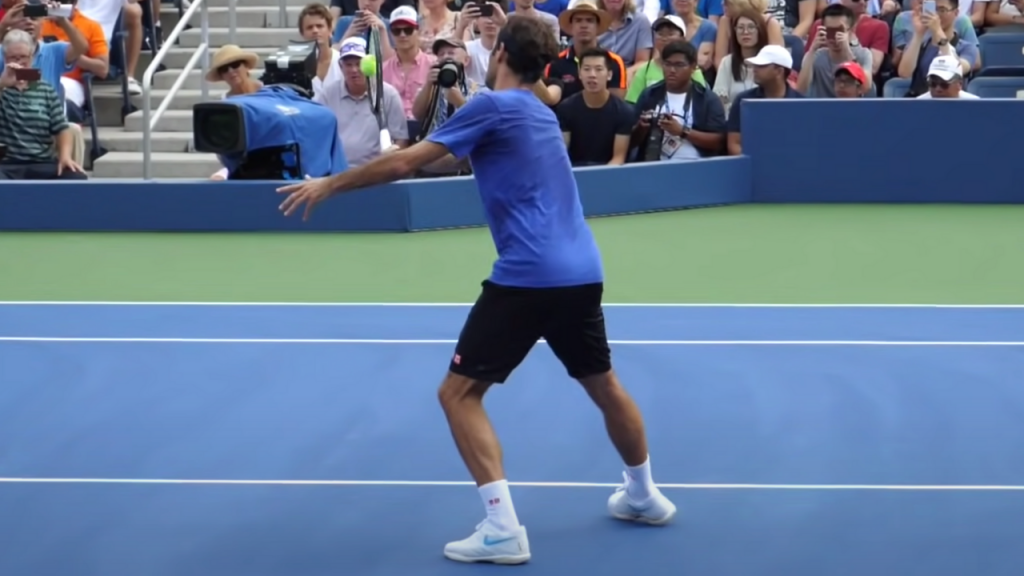
Allow your body’s momentum to carry you forward while keeping your arm motion small. Your forward body momentum, combined with a firm wrist and grip, will drive the ball down the court.
One of the most important aspects of volleying is knowing when it is an opportune time to approach the net. Knowing your opponent’s location on the tennis court, whether they are balanced or off-balance, and if they appear to be comfortable hitting the shot are all clues that you should come into the net.
Final Thoughts
Volleys are an essential part of any player’s arsenal, regardless of the style of play. Tennis is increasingly being played from the back of the court, but more advanced tennis players must still be able to attack the net to put pressure on their opponents. Volleys add another dimension to your game, allowing you to change your game plan and present your opponent with more complex challenges.
The key to good volleys is to keep things as simple as possible and guide the ball back into court with short swings. Coming to the net automatically puts your opponent under pressure by taking time away from him or her, relieving you of the pressure of having to hit huge winners from the baseline.
If you can improve your volleys to the point where you are confident at the net, it will make a huge difference in your game and give you more ways to win matches. We hope you enjoyed this article and that you can now start working on improving your volleys.
FAQs
Why Is a Volley Important in Tennis?
The main goal of a volley is to catch your opponent off guard because this shot limits your opponent’s reaction time because it is hit back so fast. It is considered an offensive shot rather than a defensive one. The shot also reduces the bad bounce effect, which is especially noticeable on grass and clay courts.
What Is a Drop Volley in Tennis?
A drop volley is a low volley that needs a very light touch. The player hitting a drop volley must try to softly hit the ball to the opposite side of the net, as close to it as possible, to increase the distance the opposing player must cover to get to it. When executed well, the ball bounces twice before your opponent can return it.
What Is a Half Volley in Tennis?
The half volley is a shot played on a very short bounce; usually, a defensive shot executed when one cannot entirely reach the opposing player’s shot up in the air and volley it.
What Is a Punch Volley in Tennis?
For a punch volley, the player at the net punches their racquet forward and slightly down, adding underspin to the ball. Punch volleys don’t need a backswing and are best for medium-fast balls with enough room over the net.
Can You Volley a Serve Back in Tennis?
The short answer is no. While it may be compelling to take the first ball out of the air by volleying it back, it is not allowed. In order for the point to begin, the server’s ball must land inside the correct service box.
Who Has the Best Net Game in Tennis Ever?
Men: Richard Krajicek, Tim Henman, Patrick Rafter, Boris Becker, Pete Sampras, Stefan Edberg, John McEnroe, Sergiy Stakhovsky, Mike Bryan, Bob Bryan, Leander Paes, Mardy Fish, Radek Stepanek, Roger Federer, Michael Llodra, Julian Benneteau.
Women: Serena Williams, Venus Williams, Roberta Vinci, Karolina Pliskova, Martina Navratilova, Martina Hingis, Lisa Raymond, Samanth Stosur, Amélie Mauresmo, Elena Dementieva.
Christoph Friedrich is a German tennis player and coach currently residing in Oakland, California. He began his tennis journey at the age of eight and has since dedicated his life to the sport. After working as a tennis coach and hitting partner in New York City for eight years, Christoph decided to share his knowledge and experience with tennis players around the world by creating the My Tennis Expert blog. His goal is to make tennis education accessible to everyone and help players select the best equipment for their game, from racquets and strings to shoes and overgrips. Christoph's extensive research and expertise in tennis technology make him a valuable resource for players of all levels.

